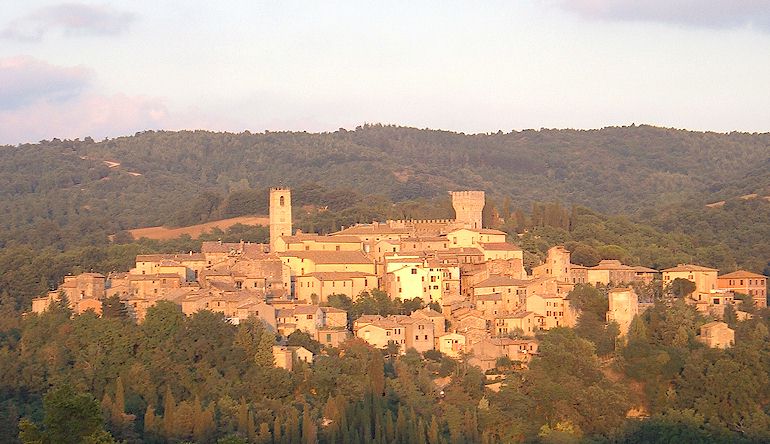
San Casciano dei Bagni |
|
|
|

San Casciano dei Bagni
|
San Casciano dei Bagni is located in Tuscany on the southern border of the province of Sienna and has been famous since the earliest times for its abundant thermal springs. The 42 springs within its territory were discovered by the Etruscans and developed by the Romans. The feudal aristocracy of the Middle Ages also made great use of them. The waters were at the height of their fame in the period between the Renaissance and the middle of the 18 C. Today, the same sources feed the ultra-modern Fonteverde Spa centre. The mediaeval centre of San Casciano is composed a maze of narrow streets, alleys and squares that wrap themselves round the hill and wind upwards towards the Collegiate and the Town Hall. All that remains of the ancient "suburbium" is the church of Santa Maria della Colonna, standing in the countryside and dating back to the 4-5 C.
Celle sul Rigo, a small village 4 km from San Casciano, is located on a hill that dominates the Paglia Valley, in front of the Monte Amiata. Its sweeping and fascinating views were much admired by the poet Giosué Carducci, during the years he spent there with his family. Palazzone, the other small village near San Casciano, is mainly rural and produces high quality wine and olive oil. The Castle of Fighine is a gem that shouldn't be missed. From the castle, you can see right over the Val di Chiana as far as the distant peaks of the Umbrian Appennines. Due to its historic heritage and magnificent surroundings, as well as its conservation policies, San Casciano has been awarded the Orange Flag and has been nominated one of the Most Beautiful Old Towns of Italy. History of San Casciano dei BagniSan Casciano takes its name from the ancient church dedicated to Saint
Casciano, to which the specification "Bagni" (baths) was added to indicate the presence of
the thermal baths of the territory. The origins of the village of San Casciano dei Bagni go back to the Etruscan and Roman
periods, when the first thermal baths were built here. During the Roman Age, the locality was known not only for the beneficial properties of its sulphuric and alkaline
springs but also for the flourishing trading activities that took
place here, due to its location close to the Via Cassia.
Main sights of San Casciano dei BagniThe CastleThe Castello di San Casciano, despite of its architectural style, was built in 1911 and is owned by the Bologna family. It overlooks Piazza Matteotti and is decorated by elegant double lancet windows and surrounded by a wide park. With its stately and mediaeval appearance, it defines the character the village of San Casciano and is visible throughout the town. Church of Saint ConceptionThis is a small 16 C Church situated in the historical town centre, near the well and the "casacce" area. It was the seat of the Compagnia della Concezione, a religious organisation dedicated to the assistance of the poor. The building has a gabled roof and a simple façade. Inside, behind the altar, there is a fresco divided into sections: at the top of the wall there is "the conception of the Virgin Mary", enriched with two plastered angels, holding back the curtains on either side of the Madonna; at the bottom of the wall, are Adam and Eve, chained to a tree, with Moses and David behind them. On either side, there are niches with Saint Peter and Saint Girolamo, and two plastered angels holding a chandelier. These frescoes are attributed to Niccolò Circignani, called Pomarancio (second half of the 16 C). Capuchin ChurchThis church was founded by the Capuchin friars on 18 October 1579, and has been partly restored to its original form. Next to this small church, there is a convent and a ruined cloister, owned by the Bologna family. This church is dedicated to the Virgin Mary and Child and it is closed all year long, except for 8 September. The interior is painted in a simple way, with flower decorations on the medallions of the walls. Above the altar, there is a painting of the Virgin with the Holy Child, over which there is a plastered and gilded crown, supported by two angels. 5 C Pagan TempleThis temple, which is probably the most ancient structure in San Casciano, is located next to the arcades of the spa. The history of its construction is uncertain. It was restored in 1920 and again in 1980, and it is likely that the temple, dedicated, possibly, to the goddess of health "Hygeia", became the ancient Pieve (parish church), also called Church of the Baths or of the Madonna of the Column. Inside there is a Renaissance altar of the 16 C situated on a podium with a canopy. Pillars and frescoes adorn the walls and there is a Roman style portal. Next to the building, vestiges of an old Franciscan convent of the 15 C, used as a refuge for the elderly, run by the Company of Saint Anthony, may be seen. This convent was also a hospice for foreigners coming to the spa for thermal cures. |
|
Val di Chiana © ammonet InfoTech 2008 - 2020. All rights reserved.